|
The
|
THE BURGENLAND BUNCH NEWS - No. 339 January 31, 2023, © 2023 by The Burgenland Bunch All rights reserved. Permission to copy excerpts granted if credit is provided. Editor: Thomas Steichen (email: tj.steichen@comcast.net) BB Home Page: the-burgenland-bunch.org BB Newsletter Archives: BB Newsletters BB Facebook Page: TheBurgenlandBunchOFFICIAL Our 27th year! The Burgenland Bunch Newsletter is issued monthly online. The BB was founded in 1997 by Gerald Berghold, who died in August 2008. |
| Current Status Of The BB: * Members: 3160 * Surname Entries: 9219 * Query Entries: 5900 * Staff Members: 14 |
| This newsletter concerns: 1) THE PRESIDENT'S CORNER 2) AVERAGE AGE AT CONCEPTION 3) HISTORICAL BB NEWSLETTER ARTICLES: - MARRIAGE DISPENSATIONS 4) ETHNIC EVENTS 5) BURGENLAND EMIGRANT OBITUARIES (courtesy of Bob Strauch) |
1) THE PRESIDENT'S CORNER (by Tom Steichen)  This
month's random bits and pieces (Article 1) begins with a piece on
the 100th Anniversary of Burgenland... sort of! Two villages were attached quite late
so are only now celebrating their 100th... read below for the details. We follow that with a
bit on a new feature at Ancestry DNA: by-parent analysis. Next are bits on two
genealogical services: see a wrap-up on what FamilySearch did in 2022 and what
GenTeam recently added to their collections. Then we have two bits that are
governmental/political in nature: a new tax in Burgenland on undeveloped building
land and a bit on how Burgenland has become a positive role model within Austria.
The final bit is one where I reveal some of my record-finding tricks. With these, you too can
become a records wizard! This
month's random bits and pieces (Article 1) begins with a piece on
the 100th Anniversary of Burgenland... sort of! Two villages were attached quite late
so are only now celebrating their 100th... read below for the details. We follow that with a
bit on a new feature at Ancestry DNA: by-parent analysis. Next are bits on two
genealogical services: see a wrap-up on what FamilySearch did in 2022 and what
GenTeam recently added to their collections. Then we have two bits that are
governmental/political in nature: a new tax in Burgenland on undeveloped building
land and a bit on how Burgenland has become a positive role model within Austria.
The final bit is one where I reveal some of my record-finding tricks. With these, you too can
become a records wizard!Our regular tidbits include the monthly BB Facebook report, book sales, a recipe (you should consider providing one!) and a humor item. The remaining articles are our standard sections: A Historical BB Newsletter article, Ethnic Events and Emigrant Obituaries. Schandorf and Luising Celebrate 100th Anniversary: We all know that Burgenland celebrated its 100th birthday in 2021. However, two villages of today's Burgenland, Luising and Schandorf, did not become part of Burgenland until 10 January 1923, so it was only in January that they celebrated their 100 years as part of Burgenland. After the November 1918 Armistice ended the First World War, negotiations about how to reconfigure the Austro-Hungarian Empire dragged out for many years. It would not be until the June 1920 Treaty of Trianon that an initial agreement was reached by the Allies to transfer Burgenland to Austria in August 1921. While the official transfer took place then, the Hungarians continued to resist, resulting in a plebiscite that returned Ödenburg (Sopron) and some surrounding villages to Hungary at the beginning of 1922. Then Austria and Hungary negotiated some land swaps, as both sides tried to fix border issues and accommodate village and large land-owner preferences (which sometimes were in opposition). It took until January 1923 to create the Burgenland of today. 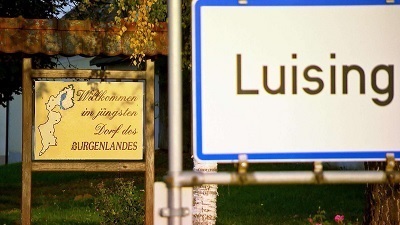 Luising
(district of Güssing) initially remained Hungarian but wanted to become Austrian, so the
Allied Border Commission explored the issue. They even asked some children in Luising
whether they spoke German or Hungarian. And the kids said, 'We're talking German. We can't
speak Hungarian." And so Luising was swapped for another village and became part of
Austria on 10 January 1923. They remain proud of that fact, even to the point that they
erected a plaque by the town sign that says: Willkommen in jüngsten Dorf des Burgenlandes
(Welcome to the youngest village in Burgenland). Luising
(district of Güssing) initially remained Hungarian but wanted to become Austrian, so the
Allied Border Commission explored the issue. They even asked some children in Luising
whether they spoke German or Hungarian. And the kids said, 'We're talking German. We can't
speak Hungarian." And so Luising was swapped for another village and became part of
Austria on 10 January 1923. They remain proud of that fact, even to the point that they
erected a plaque by the town sign that says: Willkommen in jüngsten Dorf des Burgenlandes
(Welcome to the youngest village in Burgenland).Schandorf (Oberwart district) also became part of Austria on 10 January 1923 but were pro-Hungary back then. Unlike majority ethnic-German Luising, they were majority ethnic-Croatians and their sales market was Szombathely (Steinamanger). Having little reason to prefer German-Austrian over Hungarian rule, a guerrilla resistance movement arose because the Schandorf farmers feared the loss of their market. Even though they voted against Austria, they were forced to be part of a land swap and became Austrian territory. However, like Luising, this year they held an event on that date that included a festive fair and commemorative exhibition. In my case, on the date I'm writing this, I have 6,551 predicted matches (many of which are so distant I have no real interest in them... only 486 are predicted to be 4th cousins or closer). The Maternal side (Parent-1 in my case), has 2,449 matches (she is my Burgenland side), Paternal has 3,784, Both has 1 and there are 317 in Unassigned. The Unassigned, not surprisingly, tend to be distant (all but 21 are predicted 5th cousins or further out). The Both category is slightly odd: it correctly identifies a grandson of my sister (so the grandson would be on both sides of my/our parents) but fails to identify his brother, even though I have marked him as being on both sides and he shares more DNA with me than his brother. Strange! However, both the Maternal and Paternal sides correctly identified the side for all 119 people I have confirmed. Recently, I attempted a few more match confirmations... and knowing the side involved helped reduce the effort, as it eliminated the "wrong" side from consideration. In about an hour, I added 4 confirmed matches. If you are a user of AncestryDNA, I suggest you give it a try as it does appear to be a useful addition. It should be no surprise that their website had millions of visits in 2022: 217 million is what they claim. Those visits are driven by our desire to see the now 16.88 billion searchable records and images in their historical collection. Of some surprise to me, their digital Family Tree has grown to hold 1.46 billion people! That is far more people than I would have expected. A couple of likely under-utilized categories are the 555,009 digital books that are now online (I need to do some exploring there, as the last time I looked, there were less than 10,000 available) and the 5,708 local FamilySearch centers (I used to haunt a few of these but the increased digital availability of records has pushed me to my home computer!). Perhaps their most intriguing and important accomplishment of 2022 was the introduction of artificial intelligence into handwriting recognition technology. This tool was introduced initially alongside the 1950 US Census project. AI provided the initial transcription of the Census entries and volunteers acted as a double check to make the 1950 Census database as highly accurate as possible and to make it searchable online in record time after its release by the US Archives (see FamilySearch.org/1950Census). The census contains records of more than 150 million Americans (even my older sister!). From what I can tell, the AI handwriting recognition technology is now being used to add index-entries for many of the Burgenland-area records (i.e., marriages, deaths, Lutheran records) that previously were not searchable. The latest additions affect these record collections: Austro-Hungarian Casualty Lists of World War I; Vienna: Roman Catholic Baptisms; Vienna: Roman Catholic Burials; Indices of Roman Catholic Church Registers. The casualty lists enumerate the wounded and killed soldiers as well as the prisoners of war of all Crown Lands of the Habsburg monarchy. When complete, this collection will hold 3 to 3.5 million names. The Vienna Roman Catholic Baptism additions affect parishes Landstraße, Erdberg, Gebäranstalt, Meidling, Reindorf, Neulerchenfeld, Hernals, Währing, Neustift am Walde and Sankt Brigitta. Gebäranstalt is likely of most interest to us because it documents the Alservorstadt Krankenhaus, a place where unmarried mothers were able to give birth (and where lots of orphans were cared for). The Vienna Roman Catholic Burial additions are for the parish of St. Josef. The Indices of Roman Catholic Church Registers updates affect 21 parishes in Lower Austria, two in Styria and one in Burgenland (Neuhaus am Klausenbach), as well as 5 in other areas. Sabine Goger is the contributor for Neuhaus am Klausenbach, so these are the same records she contributed to the BB and are currently available on our site.  Burgenland
To Tax Undeveloped Building Land: Last November, Burgenland passed a Spatial
Planning Act that included a new tax intended to counteract hoarding of and
speculation with building land and to reduce the conversion of agricultural and forest land to
housing. Almost 40 percent of all building plots in Burgenland are currently vacant, a
percentage that is much higher than in any other federal state in Austria, where the average
is about 23 percent. This has had the effect of inflating the price of building sites. For
example, in Gols, the average building site price had risen from 22 euros (per square
meter) in 1992 to 380 euros in 2022 (over a 17-fold increase). Similar rises have
occurred elsewhere in Burgenland. Burgenland
To Tax Undeveloped Building Land: Last November, Burgenland passed a Spatial
Planning Act that included a new tax intended to counteract hoarding of and
speculation with building land and to reduce the conversion of agricultural and forest land to
housing. Almost 40 percent of all building plots in Burgenland are currently vacant, a
percentage that is much higher than in any other federal state in Austria, where the average
is about 23 percent. This has had the effect of inflating the price of building sites. For
example, in Gols, the average building site price had risen from 22 euros (per square
meter) in 1992 to 380 euros in 2022 (over a 17-fold increase). Similar rises have
occurred elsewhere in Burgenland.The tax is intended to motivate landowners to use or sell
their building land. The amount depends on the size of the plot and the price per square
meter, with plots smaller than 300 square meters excluded from taxation. For example, for a
plot of one thousand square meters and a square meter price of 50 euros, the annual
levy is 500 euros (equal to 1% of the values of the land), and the larger the property,
the higher the tax.
Was this first Mr. Nosey Parker based on a real person? We don't know. So, where
Parker comes into it remains anyone's guess! OK, where was I? Oh yes...) He ended his message saying, "Thank you again for the links you sent; I'm curious about
your methods, but if a magician never reveals his tricks, I understand." My reply was that
I was already thinking about using this as the basis of an article where I “reveal” these
“tricks”! I had done this type of article in the past and it was time to do one again. Jack's narrative starts with an abridged refresher course in Burgenland history (for new / younger members who may have just recently started their genealogy search). You may also be interested in reading this article which discusses the possible origins of kipfels. So fix yourself some Kaffee mit Schlag, sit back and enjoy reading! The name "Burgenland" means "the land of castles." The numerous castles and walled towns were constructed as a line of defense of invasion from the West after the Magyars arrived in the 9th and 10th centuries. For thousands of years before that, the area was part of the Hallstatt culture, peopled by proto-Celtic tribes. More recently, it was overrun in turn by the Romans, Huns, Avars, Lombards, Franks and eventually the Magyars. In the late 17th century, the Ottoman Turks were driven out after ravaging the area for 250 years and, during the following period of relative peace and tranquility, the area was re-populated mainly by Germans thought to be from the Swabian area of Bavaria. A check of the German online white pages directory will show that there is a concentration of our German family names such as Fritz, Ganser and Liebentritt near the City of Ulm, which is roughly between Munich and Stuttgart, and to a lesser degree around Neumarkt in dem Tauchental (NiT) / Kethely in Burgenland, Austria. The recipe I have is from a letter my mother wrote to a friend of the family, whose mother-in-law was also from NiT. She had requested that my mother send her a copy of the recipe for "Moons" as my mother called them, because of their shape being reminiscent of a crescent moon. (This a reminder of the unsuccessful Second Siege of Vienna in 1683 by the Ottoman Turks.) My mother got the recipe from my Grandmother Gisela Fritz who called them Magdalenie Kipfels (M. Kipfels). Grandma Fritz stored the recipes in her head but my mother finally wrote them down. If you look at our family tree, Gisela had a great-grandmother named Magdelena Zartler-Fritz (1814-1849). So that's two generations back from me to Gisela, and then another three generations back from her grandmother, a total of six generations. We believe that she was the source of the kipfel recipe. My niece Stephanie has carried on the tradition of making the M. Kipfels (that's seven generations and counting...). When my two brothers and I met a couple of years ago, my one brother brought some of Stephanie's M. Kipfels with him and we all agreed that they were just like Grandma Gisela's. I also recently sent the recipe to my granddaughter, so that now makes a total of eight generations of bakers making these "Moons"! After my grandfather Johann died, my grandmother Gisela moved upstairs and we took over the first floor. I do not recall watching her make M. Kipfels but I do recall watching her make strudels on her large oak table. She would roll layer after layer of thin dough and would put fruit filling in between the various layers. I am presently sitting here typing on her oak table which we brought back to St. Louis after she sold her house. I sent a copy of the BB recipe from Ed Malesky to my mother's friend's sister-in-law, because her grandparents, who had emigrated from NiT, owned the two Muellner bakeries in Chicago. She confirmed that our M. Kipfels had the dough cut into crescents after baking, unlike Ed Malesky's kipfels, which had the dough rolled and filled before baking. My grandmother also made something that looks quite similar to Ed's but we cannot seem to determine what she called them. Here's an excerpt of the verbal directions from the letter that accompanied my mother's recipe:
|
2) AVERAGE AGE AT CONCEPTION I ran across an interesting scientific paper that estimates average age at conception for both males and females over the past 250,000 years. If interested, you can read the full paper here: Human generation times | Science Advances; the formal citation is: Human generation times across the past 250,000 years. Richard J. Wang, Samer I. Al-Saffar, Jeffrey Rogers, and Matthew W. Hahn. Science Advances, 6 Jan 2023, Vol 9, Issue 1. While the paper does not have anything directly applicable to the place or era we are most interested in, it does provide some deep background information that, if not terrible useful, is at least interesting. Before showing you the graphical results from the paper, I want to make a few points. First, this is not a study of age at first conception, rather age at all conceptions. That is important because, although males and females reach puberty at approximately the same age and thus can create a first child at similar ages, the reproductive period in males can extend more than 20 years beyond that in females. This alone suggests that males, on average, should have an older average age at conception. Second, perhaps the most medically traumatic routine human event is childbirth. While males are essentially at no risk from it, females die from it, eliminating their possibility of conception at an older age and thus reducing the average female age at conception. Beyond this, what we know of historical socio-cultural factors also suggests males might be older at conception than females... and this is what this study finds. The study chooses to express average age at conception as "generational interval" ...but it is the exact same thing. What they found was that, over the past 250,000 years, average human generation interval was 26.9 years but with an average for males of 30.7 years and for females of 23.2 years. That is, males averaged 7.5 years older than females at conception. However, the age gap has shrunk in the past 5,000 years, with the shrinking gap largely due to mothers having children at older ages. 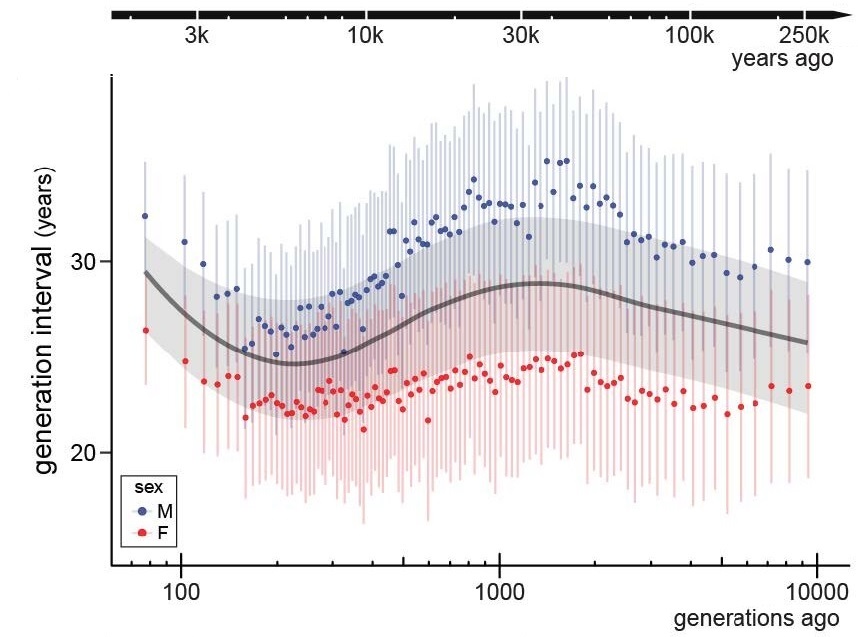 Note: The above graph shows two scales for the historical axis. The scale at the bottom is the number of generations into the past, and is presented on a log10 scale. That means the tic marks are not spaced equally nor likely represent what you first think. For example the tick marks to the right of 100 represent 200, 300, 400, etc. Those to the right of 1000 represent 2000, 3000, 4000, etc. Those to the left of 100, going backwards, represent 90, 80 and 70, so the data in the graph represent a scale of roughly 75 to 10,000 generations. The scale at the top of the graph is approximate years into the past. It is also a log10 scale with the leftmost tic mark indicating 2000 years ago. As you can see from the graph, all of these data are for times well before anything we can document by traditional genealogical methods. At its most recent, the data begins in the traditional BC era; and 250,000 years ago takes us to the tail end of the advent of homo sapiens (generally believed to have evolved between 250 and 400 thousand years ago). Thirty-eight thousand years ago (~1,400 generations ago) was the end of the last great ice age, and, if you look at the graph, that is the when the peak average human generation interval of 29.8 years occurs. From that time forward (i.e., as the world warmed again), there was a fairly constant decline in generational interval (much more noticeable in the male data but also present in the female data) that finally bottoms out about 6,000 years ago (~250 generations ago) at 24.9 years. What is significant about that time period? The earliest human civilizations developed about 6,000 years ago when the rise of agriculture and trade allowed people to have surplus food and economic stability and allowed males to take on the responsibility of a family at a much younger age. Since that time, the generational interval has been rising again, but with that for females rising more than that for males, thus decreasing the male-female difference and showing a sustained narrowing, dropping the age gap from its overall ~7.5 years down to ~5 years or less. I suspect this recent behavior had more to do with evolving societal constraints in early civilizations than anything else. One must also remember that the x-axis of the graph is not linear-scaled, so we are speaking of change over over an interval that is comparatively short relative to intervals elsewhere along the x-axis... this recent data may be merely noise rather than a true trend. The underlying study used DNA mutations to estimate these values and noted that population genetic methods typically scale history in terms of generations. This makes knowing the generation time especially important for determining the absolute timing of historic events, including migrations to new continents or gene flow back to extinct hominids. To transform these population genetic estimates into absolute time, it was commonly assumed that current generation times have persisted across hundreds of thousands of years or that studies of hunter-gatherer societies provided representative generation times across the span of human history. The authors of the paper argue that neither assumption is likely correct, saying that "the average age at which males and females have children depends on many environmental, demographic, and cultural factors that can change rapidly, while contemporary hunter-gatherer societies differ substantially from each other and from past societies." This study is an indicator that past methods for scaling to absolute time were likely wrong and offers a tool for better estimating such absolute times. Its model estimates a longer generation interval for males than females, a result consistent with studies of contemporary cultures, of which, more than 99% show a longer male generation interval, but also shows that the generational interval has varied across time, which differs from previous assumptions. |
3) HISTORICAL BB NEWSLETTER ARTICLES Editor: This is part of our series designed to recycle interesting articles from the BB Newsletters of 10 years ago, and the following is among my personal favorites (even if I did write it myself!). It is about the marriage dispensation system used by the Catholic Church. I was born into a Catholic family but have not been a practicing Catholic for almost my whole adult life. Still, over the years I've had friends that rubbed me wrong about the fees (indulgences) required by the Catholic Church to obtain a dispensation, often noting that the indulgences were one of the key reasons justifying the Protestant/Catholic split. So having the opportunity to learn more about the dispensation system was of interest to me. I hope it is for you too. THE BURGENLAND BUNCH NEWS No. 228 January 31, 2013 MARRIAGE DISPENSATIONS While helping a BB member read a note on a Burgenland Catholic marriage record, I became curious about marriage dispensations... My questions were: 1) When was dispensation needed? 2) Who could give a dispensation? 3) What were the causes/grounds justifying a dispensation? The dispensation note in the above-mentioned marriage record indicated that there was a "second degree" blood relationship that was dismissed, thus giving permission for the marriage to proceed. It should be noted that dispensations mostly affected Catholic marriages. I say mostly because the Swedish Lutherans also required dispensation for some marriages and all mixed marriages (i.e., Catholic/Protestant, of any Protestant persuasion) required dispensation for the Catholic involved in the marriage. You might ask why there existed this disparity in Catholic and Protestant practice concerning dispensation. The answer directly involves the key issue that caused the Catholic/Protestant split. That is, the Catholic Church required a Diocesan-based fee (i.e., an "indulgence") to be paid to process and obtain a dispensation. Since indulgences were the key cause of the Lutheran split, it was quite unlikely that the Lutherans and other Protestants would put themselves in a position to also require a processing payment. Thus, generally speaking, Protestants placed fewer restrictions on marriages but were far stricter about enforcing those limited restrictions. I need to provide a little more background before addressing my three questions. The Catholic Church (and most Protestant Churches) recognized what it called "Divine" or "natural" law as being distinct from "Ecclesiastical" or "Canon" law. God's "Divine/natural" law could not be dismissed; however, man's "Ecclesiastical/Canon" law was subject to being dismissed when doing so was beneficial in a particular situation for the individuals involved or for the religious community as a whole. [Note: I'll use the capitalized single word, Church, to refer to the Catholic Church in the following discussion, as it is the only denomination where most of this applies.] As for marriage, the Church recognized four classes of impediments to marriage that might be subject to dispensation. These involved certain degrees of relationship between bride and groom: 1) through blood, called consanguinity; 2) through marriage, called affinity; 3) by being god-parents in Baptism or Confirmation, called spiritual affinity; and 4) created through adoption, called legal affinity. Every direct blood-line relationship (consanguinity) between potential spouses was considered by the Church to be against Divine law, where a direct relationship was one where one spouse was sired by the other... i.e., father with daughter, granddaughter, etc; and mother with son, grandson, etc. By definition, these type of relationships could not receive a marriage dispensation. Collateral blood relationships (consanguinity), however, depended on degree. The nearest (first degree) collateral blood relationship is brother–sister. Second degree relationships included first cousins (children of parents who are siblings) and uncle–niece and aunt–nephew relationships. The simplest third degree collateral consanguinity was between second cousins. Higher degrees follow similarly. This leads to the answer to my first question, 1) When was dispensation needed? Early Church Canon law (506 AD) banned collateral marriages closer than fourth degree consanguinity. Prior to that, second degree and higher marriages were allowed. The ban was increased to seventh degree from the 11th to 13th Centuries but was then returned to fourth degree when it became apparent that most people did not know about relations that distant in degree and, even if known, the rule forbade too many potential marriages given the smallness of most towns. While the Church has never granted a dispensation for first degree consanguinity (i.e., brother–sister), second through fourth degrees were subject to dispensation starting with the 506 AD ban. It was only in 1917 that the Church allowed third degree consanguinity without dispensation; however second degree still requires dispensation. The Protestant denominations also outlawed direct blood-line consanguinity but generally permitted first cousin marriages and above (second degree and higher collateral consanguinity), citing the Mosaic regulations specified in Leviticus 18, 12–18. However, Leviticus does not explicitly mention all relationships that would be banned by this rule, so this caused some serious disagreement in the early Protestant churches, which led, in part, to the Swedish Lutheran Church establishing more strict rules (but allowing dispensation, for a rather high fee, until 1844). Both Catholic and Protestant churches now recognize local civil laws, and neither church will perform a marriage in lower degrees than that local civil law allows; however, both refuse to solemnize marriages that do not meet their own standards (even if civil law allows such). The Eastern Orthodox Church still permits only fourth and higher degree consanguinity relationships (without dispensation). Affinity, of all types, could also require dispensation by the Church. Impediment by simple affinity (i.e., by marriage), was, for example, when someone's spouse died and the widow / widower wanted to marry the brother / sister of the deceased spouse (a first degree affinity; higher degrees follow in parallel to consanguinity). Although affinity up to the fourth degree was on the books as an impediment, Catholic Burgenland records are full of such marriages. In fact, it is my impression (not backed by a serious count) that this was the most common recourse for a widow or widower with young children... a brother/sister in the deceased spouse's immediate family stepped forward to provide the replacement father or mother. Perhaps these marriages are all marked with a dispensation... but I've never noticed that. Likewise, spiritual affinity and legal affinity required dispensation. One was not allowed to marry one's God-child or an adopted child, much like marrying your own blood-line child was banned. However, I've never noted such a marriage of this type in the Church records so do not know how it was handled in practice. 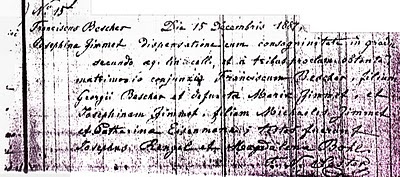 This
leaves dispensation for consanguinity, specifically collateral consanguinity of the second
through fourth degrees, for further discussion. It is the type of impediment I've seen most
often addressed in the Church records and is the type for which my original questions were
intended. This
leaves dispensation for consanguinity, specifically collateral consanguinity of the second
through fourth degrees, for further discussion. It is the type of impediment I've seen most
often addressed in the Church records and is the type for which my original questions were
intended. The second question, 2) Who could give a dispensation? is easy to answer... The Church allows the right of dispensation to be delegated down to local bishops, who handle most dispensations, though the actual right is held by the pope and has been administered from that level. However, regardless of who gives the actual dispensation, the reasons for requesting a dispensation must be placed in writing, must meet Canon law, and must (typically) be presented by the local priest for consideration. As such, it may be possible to obtain that documentation as to why a dispensation was requested in a particular case and why it was approved or rejected. [Note: I have never attempted to obtain a copy of such a document; if any of you readers have done so, I'd be interested in hearing about how you obtained a copy and what details were in the document.] I'd guess that such records, if they still exist, are in the local Diocesan archives. I'll now address my last question, 3) What were the causes/grounds justifying a dispensation? The basis for the sixteen canonical causes for matrimonial dispensation I'll list below come from an Instruction issued on 9 May, 1877 by the Church's "Sacred Congregation of the Propagation of the Faith," as this is from a time period often of interest to BB members. There was also a 1901 "Formulary of the Dataria" that gave twenty-eight causes, though the extra causes appear to be nothing more than sub-causes listed among the Instruction's 16 causes. While I have not investigated deeply, the causes listed in 1877 appear to be fully consistent with prior practice. What is interesting about the text of the Instruction
is that some explanation is given as to why a particular cause is considered sufficient (or
sufficient when considered with other causes). My take is that the Church was quite pragmatic
and expedient in its thinking (at least from its point of view). That is, it believed there
were social and religious needs that were more important than whether a single closely-related
couple married. It was considered better to maintain the social fabric and religious
solidarity than worry about following the letter of its man-made Canonical Law (called "common
law" below). |
3) ETHNIC EVENTS LEHIGH VALLEY, PA Friday, Feb. 3: Grundsaufeier at the Lancaster Liederkranz. Music by the Grundsaukapelle. Info: www.lancasterliederkranz.com Saturday, Feb. 4: Fasching at the Evergreen Heimatbund in Fleetwood. Music by Maria & John. Info: www.evergreenclub.org Sunday, Feb. 5: The Steelworkers at the Coplay Sängerbund. Info: www.coplaysaengerbund.com Friday, Feb. 10: Kinderfasching at the Lancaster Liederkranz. Info: www.lancasterliederkranz.com Saturday, Feb. 11: Fasching at the Lancaster Liederkranz. Music by The Continentals. Info: www.lancasterliederkranz.com Friday, Feb. 17: Fasching at the Reading Liederkranz. Music by The Adlers. Info: www.readingliederkranz.com Saturday, Feb. 18: Lumpenball at the Lancaster Liederkranz. Music by The Alpenländers. Info: www.lancasterliederkranz.com Saturday, Feb. 18: Mardi Gras at St. Peter’s Catholic Church in Coplay. Music by the Josef Kroboth Orchestra. Info and tickets: bmsobchak@verizon.net Sunday, Feb. 19: St Valentine’s Day Dance at the Coplay Sängerbund. Music by the Emil Schanta Band. Info: www.coplaysaengerbund.com Friday, Feb 24: Josef Kroboth Orchestra at the Evergreen Heimatbund in Fleetwood. Info: www.evergreenclub.org Sunday, Feb. 26: Josef Kroboth Orchestra at the Coplay Sängerbund. Info: www.coplaysaengerbund.com NEW BRITAIN, CT Friday-Sunday, 1-8 pm: Biergarten is open. Austrian Donau Club, 545 Arch Street. ST. LOUIS, MO (none) UPPER MIDWEST (none) |
|
|
| END OF NEWSLETTER (Even good things must end!) |
|
Burgenland Bunch Newsletter, copyright © 2023 by The Burgenland
Bunch |
 News
News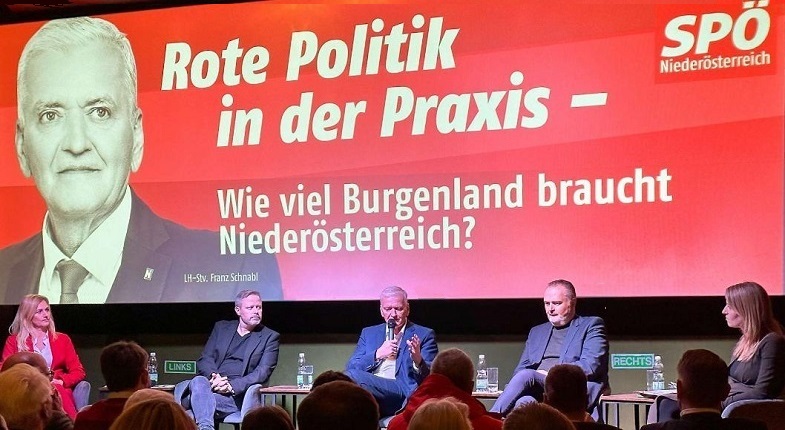
 and the birthplace for Rudolph (Senior), as well as his birth year (it was listed as 1903 in
his marriage record), all matched what I was looking for, so I pulled up the census image:
and the birthplace for Rudolph (Senior), as well as his birth year (it was listed as 1903 in
his marriage record), all matched what I was looking for, so I pulled up the census image: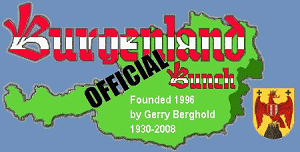 The
Facebook Bunch (from Vanessa Sandhu):
The
Facebook Bunch (from Vanessa Sandhu): Update
for book "The Burgenländer Emigration to America": Here is this month's update on
purchases of the English issue of the 3rd edition of Dr. Walter Dujmovits' book "Die
Amerika-Wanderung Der Burgenländer."
Update
for book "The Burgenländer Emigration to America": Here is this month's update on
purchases of the English issue of the 3rd edition of Dr. Walter Dujmovits' book "Die
Amerika-Wanderung Der Burgenländer." Magdeline Fritz "Moon" Kipfels
Magdeline Fritz "Moon" Kipfels

 John
Veszelovits, 86, of Norwood, New Jersey, passed away on Friday, December 9, 2022. Beloved
husband of Lilly (née Kurta) for 59 years. Cherished father of Carol Varesi and her partner
Douglas Carosella, Kathe Carrero and Anthony Veszelovits. Dear grandfather of Nicholas,
Jillian and Grace. Dearest brother of Elizabeth, Theresa and the late Rose, Mary, Stephen,
William, Barbara, Louis, Cecilia, Louis and Hedwig.
John
Veszelovits, 86, of Norwood, New Jersey, passed away on Friday, December 9, 2022. Beloved
husband of Lilly (née Kurta) for 59 years. Cherished father of Carol Varesi and her partner
Douglas Carosella, Kathe Carrero and Anthony Veszelovits. Dear grandfather of Nicholas,
Jillian and Grace. Dearest brother of Elizabeth, Theresa and the late Rose, Mary, Stephen,
William, Barbara, Louis, Cecilia, Louis and Hedwig.